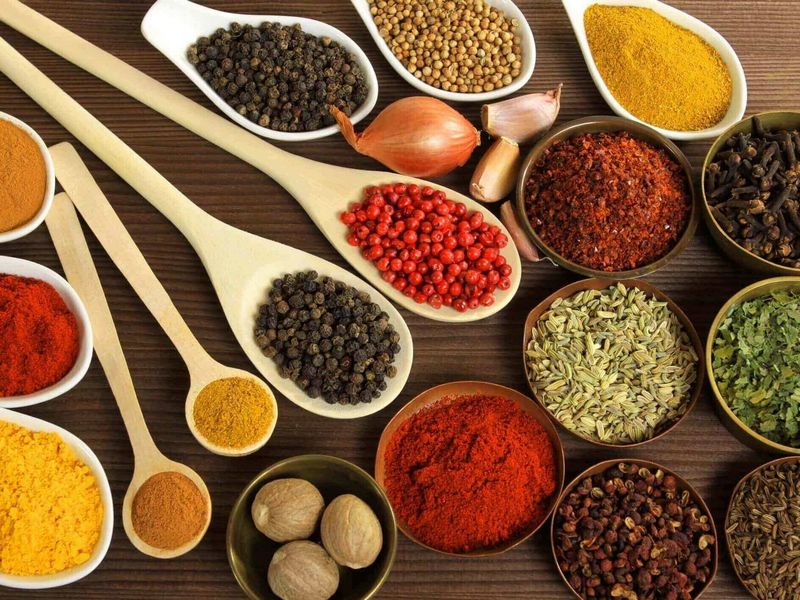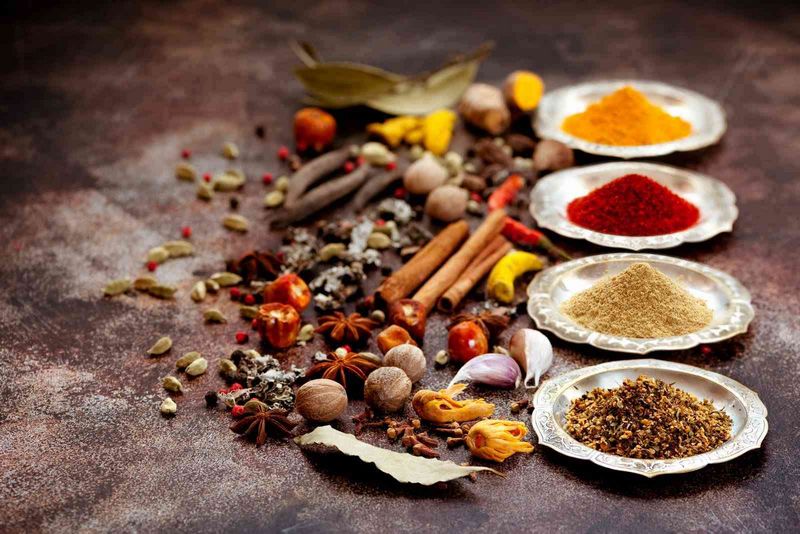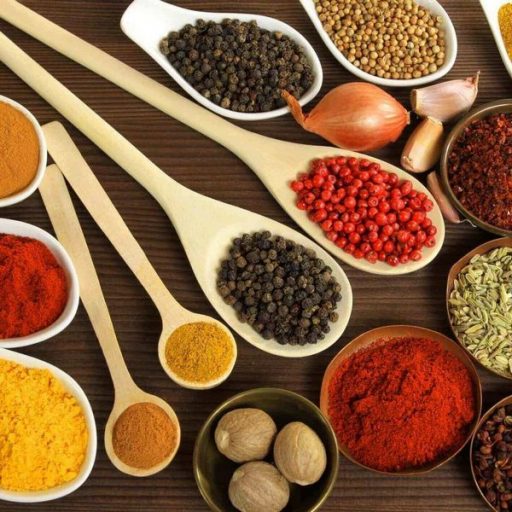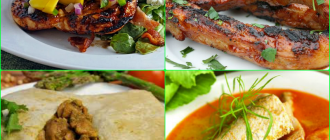
Exploring the Vibrant World of Indian Cuisine: A Kaleidoscope of Spices, Curries, and More
Indian cuisine is a vibrant and diverse culinary tradition that has captured the hearts and taste buds of people around the world. Known for its bold flavors and rich spices, Indian food is a celebration of the country’s diverse regional cuisine.
One of the most iconic dishes in Indian cuisine is tikka masala, a creamy and flavorful curry made with marinated meat or vegetables. The dish is known for its vibrant red color and aromatic spices, such as cumin, coriander, and turmeric. Tikka masala is often served with fragrant basmati rice or fluffy naan bread, which is perfect for soaking up the delicious sauce.
Indian cuisine is also renowned for its wide variety of vegetarian dishes. Dal, a lentil soup, is a staple in Indian households and is often flavored with spices like cumin, mustard seeds, and garam masala. Another popular vegetarian dish is samosas, crispy pastry pockets filled with a savory mixture of potatoes, peas, and spices. These delicious snacks are perfect for a quick bite or as an appetizer.
Biryani is another beloved dish in Indian cuisine, known for its fragrant rice cooked with meat, vegetables, and a blend of aromatic spices. The dish is often garnished with fried onions and served with raita, a cooling yogurt sauce. Biryani is a perfect example of the complex flavors and layering of spices that make Indian cuisine so unique.
No Indian meal is complete without a refreshing beverage like mango lassi, a sweet and creamy yogurt-based drink flavored with fresh mangoes. Another popular drink is chai, a spiced tea made with a blend of black tea, milk, and aromatic spices like cardamom, cinnamon, and ginger. These beverages provide a perfect balance to the bold and spicy flavors of Indian cuisine.
Indian cuisine is also known for its use of tandoori cooking, where meat or vegetables are marinated in a mixture of yogurt and spices, then cooked in a clay oven. This method of cooking imparts a smoky and charred flavor to the dishes, creating a unique taste experience. Tandoori chicken and tandoori naan are popular examples of this style of cooking.
Whether you’re a fan of spicy curries, flavorful biryanis, or comforting dosas, Indian cuisine offers a wide range of dishes to satisfy every palate. With its vibrant colors, aromatic spices, and diverse flavors, Indian food is a true reflection of the country’s rich food culture and culinary heritage. So grab a plate of delicious masala dosa or a bowl of fragrant biryani, and embark on a culinary journey through the colorful palette of Indian cuisine.
Exploring the Rich Flavors of Indian Spices
Indian cuisine is renowned for its vibrant and diverse flavors, which are largely due to the extensive use of spices. From vegetarian dishes like dal and naan to popular beverages like chai and mango lassi, Indian food is a celebration of spices.
One of the most popular spices used in Indian cuisine is masala, a blend of various spices that adds depth and complexity to dishes. Whether it’s a hearty curry or a flavorful biryani, masala is often the star of the show.
Each region in India has its own unique spice blends and cooking techniques, resulting in a wide variety of flavors and culinary traditions. For example, the southern region of India is known for its use of coconut and curry leaves, while the northern region is famous for its rich and creamy gravies.
Basmati rice, a fragrant long-grain rice, is a staple in Indian cuisine and serves as the perfect accompaniment to many dishes. It is often cooked with ghee, a clarified butter that enhances the flavors of the spices.
Indian street food is another highlight of the country’s food culture. From crispy samosas to savory dosas, these quick and delicious snacks are bursting with flavor and are beloved by locals and tourists alike.
And let’s not forget about the iconic tikka masala, a creamy and spicy tomato-based curry that has gained popularity around the world. It is often enjoyed with naan, a soft and fluffy bread that is perfect for soaking up the flavorful sauce.
Whether you’re a fan of vegetarian dishes or meaty curries, Indian cuisine offers a wide range of options to satisfy every palate. Its bold flavors and aromatic spices make it a truly unique and exciting culinary experience.
The Art of Making Traditional Indian Curries
Indian cuisine is renowned for its rich and diverse flavors, and one of the most iconic dishes that exemplifies this is the traditional Indian curry. Curries in India vary greatly from region to region, each with its own unique blend of spices and ingredients. From the fiery hot curries of South India to the creamy and aromatic curries of the North, there is a curry to suit every palate in Indian food culture.
The key to making a delicious Indian curry lies in the careful selection and combination of spices. A typical curry will include a variety of spices such as cumin, coriander, turmeric, and garam masala, which are toasted and ground to release their flavors. These spices are then sautéed in ghee or oil to create a fragrant base for the curry.
In addition to spices, curries often include a variety of other ingredients such as onions, garlic, ginger, and tomatoes. These ingredients are cooked down until they form a thick and flavorful sauce. Depending on the region and the type of curry, additional ingredients such as coconut milk, yogurt, or cream may be added to enhance the richness and creaminess of the sauce.
Curries can be made with a wide range of proteins, including meat, fish, and vegetables. In India, vegetarian curries are particularly popular, with dishes such as dal (lentils), paneer tikka (grilled cheese), and chana masala (chickpeas) being staples of the Indian vegetarian diet.
Once the curry is cooked, it is typically served with a side of rice or bread. Basmati rice, known for its fragrant aroma and delicate flavor, is a popular choice. Naan, a soft and fluffy bread, is another common accompaniment. Other types of bread, such as roti or paratha, may also be served.
Indian curries are not only enjoyed at home but also on the streets of India, where street food vendors offer a variety of delicious curry dishes. From spicy samosas and crispy dosas to flavorful biryanis and tangy chaat, Indian street food is a treasure trove of curry-based delights.
Whether enjoyed at home or in a bustling street market, a well-made Indian curry is a culinary masterpiece that embodies the vibrant and diverse flavors of India.
Delicious Indian Street Food: A Gastronomic Adventure
When it comes to exploring the vibrant and diverse food culture of India, one cannot overlook the tantalizing world of Indian street food. From the bustling streets of Delhi to the coastal towns of Kerala, every region has its own unique street food specialties that are sure to delight your taste buds.
One of the highlights of Indian street food is the explosion of flavors that come from the use of spices. From the aromatic cumin and coriander to the fiery red chili powder, each dish is infused with a medley of spices that create a symphony of taste. Whether it’s the savory masala dosa or the fragrant biryani, every bite is a burst of flavor.
No street food adventure in India is complete without indulging in a cup of chai or a refreshing mango lassi. The piping hot chai, made with a blend of tea leaves, milk, and spices, is the perfect pick-me-up to start your day. And the creamy mango lassi, made with fresh mangoes and yogurt, is a cooling treat on a hot summer day.
Vegetarians will be delighted to find a plethora of options in Indian street food. From the crispy samosas filled with spiced potatoes and peas to the comforting dal served with fluffy basmati rice, there is no shortage of vegetarian delights. And let’s not forget the pillowy soft naan bread, perfect for scooping up every last bit of curry.
One cannot talk about Indian street food without mentioning the iconic tandoori dishes. Whether it’s the smoky tandoori chicken or the succulent tandoori paneer, these dishes are marinated in a blend of spices and cooked in a traditional clay oven, resulting in a juicy and flavorful dish that is hard to resist.
And let’s not forget about the indulgent use of ghee in Indian street food. This clarified butter adds a rich and buttery flavor to dishes like butter chicken and ghee dosa, elevating them to a whole new level of deliciousness.
So, if you’re ready for a gastronomic adventure, grab a plate and hit the streets of India to experience the mouthwatering world of Indian street food. From the vibrant colors to the bold flavors, every bite is a journey through the diverse and delicious cuisine of this incredible country.
Regional Varieties of Indian Cuisine: From North to South
India is a country known for its diverse food culture and regional culinary traditions. From the north to the south, each region offers a unique and flavorful experience. In the northern part of India, dishes like masala chai, samosas, and biryani are popular. Masala chai, a spiced tea, is a staple beverage enjoyed throughout the day. Samosas, deep-fried pastries filled with a savory mixture of potatoes, peas, and spices, are a popular street food snack. Biryani, a fragrant rice dish cooked with meat or vegetables, is a beloved main course.
In the southern part of India, the cuisine is known for its use of rice and spices. Basmati rice, a fragrant long-grain rice, is a staple in many South Indian dishes. Naan, a type of bread made from wheat flour, is often served with curries and dal, a lentil soup. Dosa, a thin and crispy pancake made from fermented rice and lentil batter, is a popular breakfast item. The cuisine of the south is also known for its vegetarian options, with many dishes using a variety of vegetables and lentils.
Indian street food is a vibrant part of the country’s culinary scene, and each region has its own specialties. In the north, popular street food items include tikka masala, a spicy grilled chicken dish, and chaat, a savory snack made with crispy fried dough, potatoes, and various chutneys. In the south, you’ll find dishes like vada pav, a spicy potato fritter sandwich, and pani puri, hollow puris filled with a tangy tamarind water.
Tandoori cooking, where food is marinated in a mixture of yogurt and spices and cooked in a clay oven, is popular throughout India. Tandoori chicken and tandoori naan are common dishes enjoyed across the country. Ghee, or clarified butter, is a key ingredient in many Indian dishes, adding richness and flavor. Mango lassi, a refreshing yogurt-based drink, is a popular beverage enjoyed throughout India.
Overall, the regional varieties of Indian cuisine offer a wide range of flavors, spices, and cooking techniques. From the hearty and aromatic curries of the north to the spicy and flavorful dishes of the south, Indian cuisine is a true culinary adventure.
Vegetarian Delights: The Heart of Indian Cooking
Indian cuisine is renowned for its vibrant and diverse flavors, and at the heart of it all lies the vegetarian delights that have become synonymous with Indian cooking. From the bustling streets of India to the finest restaurants, vegetarian dishes are a staple in every corner of the country.
One of the most popular vegetarian dishes in India is the tandoori, which is a traditional style of cooking that involves marinating vegetables in a flavorful blend of spices and then grilling them in a clay oven. The result is a smoky and delicious dish that is loved by people of all ages.
Another vegetarian favorite is the dosa, a thin and crispy pancake made from fermented rice and lentil batter. It is often served with a variety of chutneys and sambar, a lentil-based vegetable stew. The dosa is a staple breakfast item in South India and is enjoyed by people across the country.
Indian street food is also a treasure trove of vegetarian delights. From the famous samosas, which are deep-fried pastries filled with spiced potatoes and peas, to the mouthwatering chaat, a savory snack made with crispy fried dough, yogurt, and various chutneys, Indian street food offers a wide range of vegetarian options that are bursting with flavors.
When it comes to regional cuisine, each state in India has its own unique vegetarian dishes to offer. From the aromatic biryani of Hyderabad to the rich and creamy dal makhani of Punjab, the variety of vegetarian dishes in India is truly remarkable.
Indian cuisine is also known for its generous use of spices, which add depth and complexity to vegetarian dishes. From the fragrant masala, a blend of spices that forms the base of many curries, to the aromatic ghee, a clarified butter that is used for cooking and flavoring, spices play a crucial role in Indian cooking.
No discussion of vegetarian delights in Indian cuisine would be complete without mentioning the refreshing mango lassi and the warming chai. The mango lassi is a sweet and creamy yogurt-based drink that is made with fresh mangoes, while the chai is a spiced tea that is enjoyed throughout the day.
Whether it’s the comforting curry, the aromatic biryani, or the flavorful tikka masala, vegetarian delights are truly the heart and soul of Indian cooking. With its rich food culture and diverse flavors, Indian cuisine continues to captivate food lovers around the world.
Sweet Treats: Indulging in Indian Desserts
Indian cuisine is renowned for its rich and diverse flavors, and the same holds true for its desserts. From traditional sweets to innovative creations, Indian desserts offer a delightful end to any meal.
One popular Indian dessert is the Mango Lassi, a refreshing and creamy drink made with yogurt, mango pulp, and a touch of cardamom. It is a perfect blend of sweet and tangy flavors and is often enjoyed during the summer months.
Indian food culture is known for its use of spices, and this extends to its desserts as well. Chai Masala is a spiced tea that is often enjoyed with a sweet treat. The warm spices like cinnamon, ginger, and cloves add a unique flavor to the tea, making it a perfect accompaniment to desserts.

Each region in India has its own unique desserts that showcase the flavors and ingredients of that area. For example, in the northern region, you can find Gulab Jamun, soft and spongy milk dumplings soaked in a sweet syrup. In the southern region, Payasam, a creamy rice pudding flavored with cardamom and garnished with nuts, is a popular choice.
Indian desserts are not limited to just sweets. Savory snacks like samosas and tikka masala are also considered desserts in some parts of the country. These deep-fried pastries filled with spiced potatoes or minced meat are enjoyed as a sweet and savory treat.
Indian desserts often incorporate ingredients like ghee, a clarified butter, and dairy products like milk and yogurt. These ingredients add richness and a creamy texture to the desserts. They are also often flavored with aromatic spices like cardamom, saffron, and rose water.
Whether it’s the crispy dosa from the south, the creamy kulfi from the north, or the sweet jalebi from the east, Indian desserts offer a wide range of flavors and textures to satisfy any sweet tooth. So, next time you indulge in Indian cuisine, don’t forget to save room for a delicious and indulgent Indian dessert.
Indian Breads: The Perfect Accompaniment to Every Meal
In Indian cuisine, bread plays a vital role as a staple food and is an essential part of every meal. With a diverse regional cuisine, there are numerous types of Indian breads that are enjoyed across the country. One of the most popular and well-known is naan, a soft and fluffy bread that is traditionally cooked in a tandoori oven.
Indian breads are incredibly versatile and can be enjoyed with a wide range of dishes. Whether you’re a vegetarian or a meat lover, there is a bread to complement every meal. From samosas and tikka masala to biryani and dal, Indian breads are the perfect accompaniment to soak up the flavors of these delicious dishes.
One of the most famous Indian breads is roti, a simple bread made from whole wheat flour. It is often served with curries and lentils, adding a wholesome element to the meal. Another popular choice is paratha, a flaky and layered bread that is often stuffed with various fillings like potato, paneer, or spinach.
For those who prefer rice, basmati rice is a common side dish that is often served with Indian meals. However, Indian breads offer a different texture and flavor profile that can elevate any dish. They can be enjoyed plain or with a generous slathering of ghee, a clarified butter that adds richness and depth of flavor.
Indian breads are made using a variety of techniques and ingredients, including different flours and spices. They can be cooked on a tawa, a flat griddle, or in a tandoori oven, which gives them a unique smoky flavor. The use of spices like cumin, coriander, and fenugreek in the dough adds an aromatic touch to the breads.
Whether you’re enjoying a meal at a restaurant or indulging in Indian street food, breads like naan, roti, and paratha are always a popular choice. They can be enjoyed on their own or used to scoop up delicious curries and chutneys. And to wash it all down, a refreshing mango lassi or a cup of chai is the perfect accompaniment to complete the Indian food experience.
Spices as Medicine: The Health Benefits of Indian Cuisine
Indian cuisine is renowned for its vibrant flavors and extensive use of spices. These spices not only add depth and complexity to dishes like naan, tikka masala, and biryani, but they also offer a wide range of health benefits. From improving digestion to boosting immunity, the spices used in Indian cuisine have been used for centuries as natural remedies.
One of the key spices used in Indian cuisine is turmeric. This bright yellow spice contains a compound called curcumin, which has powerful anti-inflammatory properties. Turmeric is often used in curries and dal, and its consumption has been linked to a reduced risk of chronic diseases such as heart disease, cancer, and Alzheimer’s.
Cumin is another common spice in Indian cuisine. It aids in digestion and helps relieve gastrointestinal issues such as bloating and indigestion. Cumin is often used in dishes like curry and tandoori, adding a warm and earthy flavor.
Ginger, a popular spice in Indian cuisine, is known for its anti-inflammatory and antioxidant properties. It is often used in chai tea and masala dishes, as well as in ginger-infused drinks. Ginger can help alleviate nausea, reduce muscle pain, and improve digestion.
Indian cuisine also incorporates a variety of other spices, such as coriander, cardamom, and fenugreek, each with their own unique health benefits. Coriander is rich in antioxidants and can help regulate blood sugar levels. Cardamom aids in digestion and freshens breath. Fenugreek is known for its anti-inflammatory properties and is often used to lower cholesterol levels.
Indian cuisine is also known for its vegetarian and plant-based options, making it a great choice for those looking to adopt a healthier lifestyle. Dishes like samosas, dosa, and mango lassi can be enjoyed without the guilt, as they are often made with nutritious ingredients like lentils, vegetables, and yogurt.
In conclusion, the spices used in Indian cuisine not only enhance the flavors of the dishes but also offer a wide range of health benefits. From turmeric’s anti-inflammatory properties to cumin’s aid in digestion, these spices have been used for centuries as natural remedies. So next time you enjoy a delicious Indian meal, remember that you’re not only treating your taste buds but also nourishing your body.
The Influence of Indian Cuisine on Global Culinary Trends
Indian cuisine has made a significant impact on global culinary trends, with its rich flavors, vibrant colors, and diverse range of dishes. One of the most popular dishes that has gained worldwide recognition is the dosa, a thin and crispy pancake made from fermented rice and lentil batter. This South Indian specialty has become a favorite among food enthusiasts for its unique taste and versatility.
Indian food culture, with its emphasis on spices and aromatic ingredients, has also influenced global cooking styles. The use of spices such as cumin, coriander, turmeric, and cardamom has become common in various cuisines around the world. Additionally, the popularity of basmati rice, known for its fragrant aroma and long grains, can be attributed to its use in Indian biryanis and other rice-based dishes.
Ghee, a clarified butter commonly used in Indian cooking, has also found its way into global kitchens. Its rich and nutty flavor adds depth to dishes and is often used in both sweet and savory preparations. Similarly, Indian regional cuisines, known for their distinct flavors and cooking techniques, have inspired chefs worldwide to experiment with new flavors and ingredients.
Indian cuisine has also played a major role in promoting vegetarianism globally. With its wide array of delicious vegetarian dishes, such as dal (lentil soup), samosas (stuffed pastries), and various vegetable curries, Indian food has shown that vegetarian meals can be both flavorful and satisfying.
Popular Indian dishes like tikka masala, mango lassi, and chai have become staple items in menus across the globe. The popularity of Indian street food, with its bold flavors and unique combinations, has also influenced the street food scene in many countries.
Furthermore, Indian cooking techniques like tandoori (clay oven) and naan (oven-baked flatbread) have been adopted in various cuisines, adding a touch of India’s culinary heritage to dishes worldwide. The use of masala (spice blend) in both sweet and savory dishes has also become a global trend, adding depth and complexity to various cuisines.
In conclusion, Indian cuisine has had a profound influence on global culinary trends. From its diverse range of flavors to its use of spices and cooking techniques, Indian food has become a source of inspiration for chefs and food enthusiasts worldwide.
Indian Fusion Cuisine: Blending Traditions with Modernity
Indian cuisine is known for its vibrant flavors, aromatic spices, and rich food culture. It has a long history and diverse regional cuisines that vary from north to south and east to west. In recent years, there has been a rise in Indian fusion cuisine, which combines traditional Indian dishes with modern cooking techniques and ingredients.
One popular example of Indian fusion cuisine is the fusion of Indian street food with international flavors. Dishes like Indian-style tacos and burgers have become popular, where traditional Indian ingredients like tikka masala and ghee are used in creative ways. These fusion dishes offer a unique blend of flavors and textures, combining the best of both worlds.
Another trend in Indian fusion cuisine is the incorporation of traditional dishes into modern recipes. For example, dosa, a popular south Indian dish made from fermented rice and lentil batter, has been transformed into dosa wraps and dosa pizzas. This fusion of traditional and modern elements adds a new twist to classic Indian dishes.
Indian breads like naan and paratha have also been given a modern twist. They are now stuffed with a variety of fillings, such as cheese, spinach, and even chocolate. These stuffed breads offer a delightful combination of flavors and textures, making them a favorite among food enthusiasts.
Vegetarianism is a prominent aspect of Indian cuisine, and it has also found its way into fusion dishes. Many Indian fusion restaurants offer a wide range of vegetarian options that cater to the growing demand for plant-based meals. Dishes like vegetarian tikka masala, dal, and tandoori tofu are popular choices for those looking for a meat-free alternative.
Indian beverages like chai and lassi have also been given a modern twist. They are now infused with flavors like masala, fruit, and even alcohol. These creative variations of traditional Indian drinks offer a refreshing and unique experience.
In conclusion, Indian fusion cuisine is an exciting blend of traditional Indian dishes and modern culinary techniques. It offers a diverse range of flavors, textures, and ingredients that appeal to both Indian and international palates. Whether it’s the fusion of Indian street food with international flavors or the incorporation of traditional dishes into modern recipes, Indian fusion cuisine is a celebration of the rich and vibrant food culture of India.
Traditional Indian Drinks: From Chai to Lassi
When it comes to traditional Indian drinks, there is a wide variety to choose from that perfectly complement the vibrant flavors of Indian cuisine. From the warming and aromatic chai to the refreshing and creamy lassi, these drinks are an integral part of India’s food culture.
Chai, also known as masala chai, is a popular spiced tea that is enjoyed throughout India. Made by brewing black tea with a blend of aromatic spices such as cardamom, cinnamon, ginger, and cloves, chai is a comforting and invigorating drink. It is often sweetened with sugar and served with a splash of milk. Chai is commonly enjoyed alongside a hearty meal of tandoori chicken, samosas, or biryani.
Lassi, on the other hand, is a yogurt-based drink that is available in both sweet and savory variations. Sweet lassi is made by blending yogurt with sugar and flavored with ingredients like mango, rose, or saffron. It is a popular choice during the hot summer months as it provides a cooling and refreshing respite. Savory lassi, also known as salted lassi, is made by adding spices like cumin and black salt to yogurt. It is often enjoyed as a digestive aid after a heavy meal of dal, tikka masala, or dosa.
India’s diverse regional cuisine also reflects in its traditional drinks. For example, in the state of Punjab, a popular drink called chaas is made by whisking yogurt with water and seasoning it with spices like cumin and mint. In the southern regions of India, a drink called neer mor is made by diluting yogurt with water and flavored with curry leaves and green chilies. These regional variations add to the rich tapestry of Indian drinks.
Whether it’s a steaming cup of chai to start the day or a refreshing glass of lassi to cool down, traditional Indian drinks are an essential part of the country’s culinary heritage. They not only enhance the flavors of the food but also provide a glimpse into the diverse and vibrant food culture of India.
Exploring the Rich Culinary Heritage of India
India is a country with a diverse and vibrant food culture, known for its wide range of flavors and spices. From the famous tandoori dishes to the refreshing mango lassi, Indian cuisine offers a culinary experience like no other. Each region has its own distinct flavors and specialties, making it a haven for food lovers.
One of the key ingredients in Indian cooking is ghee, a clarified butter that adds richness and flavor to dishes. It is commonly used in curries, biryanis, and even desserts. Speaking of curry, it is a staple in Indian cuisine and comes in various forms, such as butter chicken, chicken tikka masala, and vegetable curry. The use of spices is also a defining characteristic of Indian cuisine, with blends like garam masala and tandoori masala adding depth and complexity to dishes.
Vegetarian food is also an important part of Indian cuisine, with a wide variety of dishes that cater to those who prefer a plant-based diet. Dal, a lentil stew, is a popular vegetarian dish that is often enjoyed with rice or bread. Another favorite vegetarian option is samosas, crispy pastry pockets filled with spiced potatoes and peas.
Indian street food is a must-try for anyone visiting the country. From the savory dosa, a thin rice and lentil pancake filled with a variety of fillings, to the fragrant biryani, a flavorful rice dish cooked with meat or vegetables, Indian street food offers a burst of flavors and textures. And of course, no street food experience is complete without a cup of chai, a spiced tea that is loved by locals and tourists alike.
To complete any Indian meal, one must indulge in the classic accompaniments of basmati rice and naan bread. Basmati rice, known for its fragrant aroma and long grains, pairs perfectly with curries and biryanis. Naan, a soft and fluffy bread, is often enjoyed with a side of butter or used to scoop up curries.
Overall, Indian cuisine is a treasure trove of flavors, colors, and aromas. With its rich culinary heritage and diverse regional cuisines, it offers a culinary journey that is sure to delight the senses.
Indian Cuisine for Beginners: Essential Ingredients and Techniques
Indian cuisine is known for its rich flavors, vibrant colors, and diverse range of dishes. Whether you’re a seasoned foodie or just starting to explore the world of Indian cooking, there are a few essential ingredients and techniques that you should know.
- Spices: Spices are the heart and soul of Indian cuisine. From cumin and coriander to turmeric and cardamom, Indian dishes are known for their bold and aromatic flavors. Don’t be afraid to experiment with different spice combinations to create your own unique curry blends.
- Curry: Curry is a staple in Indian cuisine and refers to a variety of dishes made with a combination of spices, herbs, and other ingredients. Whether it’s a creamy chicken tikka masala or a spicy vegetable curry, there are countless variations to explore.
- India: Indian cuisine is deeply rooted in the country’s rich cultural heritage. Each region of India has its own unique culinary traditions and flavors, from the biryani of Hyderabad to the dosas of South India.
- Biryani: Biryani is a popular rice dish that is often made with fragrant basmati rice, meat (such as chicken or lamb), and a blend of spices. It is typically cooked in layers to create a flavorful and aromatic one-pot meal.
- Naan: Naan is a type of Indian bread that is traditionally cooked in a tandoor (a clay oven). It is typically served alongside curries and other dishes to soak up the flavorful sauces.
- Chai: Chai, or Indian spiced tea, is a popular beverage in India. It is made by boiling tea leaves with milk, spices (such as cardamom and ginger), and sweetener (such as sugar or honey).
- Ghee: Ghee is a type of clarified butter that is commonly used in Indian cooking. It adds a rich and nutty flavor to dishes and is often used for sautéing, frying, or as a spread.
- Dal: Dal, or lentils, are a staple in Indian cuisine. They are often cooked with spices and served as a side dish or as a main course with rice or bread.
- Masala: Masala refers to a blend of spices that is used in many Indian dishes. It can be a combination of whole or ground spices and is often used to add depth and flavor to c






